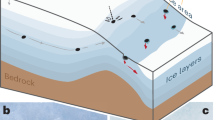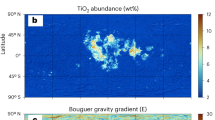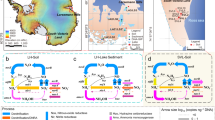Abstract
The expansion and contraction of sulfidic depositional conditions in the oceans can be tracked with the isotopic composition of molybdenum in marine sediments. However, molybdenum-isotope data are often subject to multiple conflicting interpretations. Here I present a compilation of molybdenum-isotope data from three time intervals: the Toarcian Oceanic Anoxic Event about 183 million years ago, Oceanic Anoxic Event 2 about 94 million years ago, and two early Eocene hyperthermal events from 56 to 54 million years ago. A comparison of data from sites located in different hydrographic settings tightly constrains the molybdenum cycle for these intervals, allowing a direct comparison of the expanse of sulfidic conditions in each interval compared to today. Nonetheless, tracing rates of redox change over such rapid climatic events using molybdenum isotopes remains challenging. Future efforts to achieve this goal might be accomplished by analysing specific mineral phases, using complementary redox-sensitive geochemical techniques and by linking isotopic observations with Earth system modelling. Such improvements will make it possible to more fully assess the links between ocean deoxygenation, climatic and oceanographic changes, and biotic turnover.
This is a preview of subscription content, access via your institution
Access options
Access Nature and 54 other Nature Portfolio journals
Get Nature+, our best-value online-access subscription
$29.99 / 30 days
cancel any time
Subscribe to this journal
Receive 12 print issues and online access
$259.00 per year
only $21.58 per issue
Buy this article
- Purchase on Springer Link
- Instant access to full article PDF
Prices may be subject to local taxes which are calculated during checkout



Similar content being viewed by others
References
Jenkyns, H. C. Geochemistry of oceanic anoxic events. Geochem. Geophys. Geosyst. 11, Q03004 (2010).
Ridgwell, A. & Schmidt, D. N. Past constraints on the vulnerability of marine calcifiers to massive carbon dioxide release. Nat. Geosci. 3, 196–200 (2010).
Kendall, B., Dahl, T. W. & Anbar, A. D. Good golly, why moly? The stable isotope geochemistry of molybdenum. Rev. Mineral. Geochem. 82, 683–732 (2017).
Arnold, G. L., Anbar, A. D., Barling, J. & Lyons, T. W. Molybdenum isotope evidence for widespread anoxia in mid-Proterozoic oceans. Science 304, 87–90 (2004).
Pearce, C. R., Cohen, A. S., Coe, A. L. & Burton, K. W. Molybdenum isotope evidence for global ocean anoxia coupled with perturbations to the carbon cycle during the Early Jurassic. Geology 36, 231–234 (2008).
Dickson, A. J., Cohen, A. S. & Coe, A. L. Seawater oxygenation during the Paleocene–Eocene Thermal Maximum. Geology 40, 639–642 (2012).
Dickson, A. J., Jenkyns, H. C., Porcelli, D., van den Boorn, S. & Idiz, E. Basin-scale controls on the molybdenum isotope composition of seawater during Oceanic Anoxic Event 2 (Late Cretaceous). Geochim. Cosmochim. Acta 178, 291–306 (2016).
Westermann, S., Vance, D., Cameron, V., Archer, C. & Robinson, S. A. Heterogeneous oxygenation states in the Atlantic and Tethys oceans during Oceanic Anoxic Event 2. Earth Planet. Sci. Lett. 404, 178–189 (2014).
Kendall, B. et al. Uranium and molybdenum isotope evidence for an episode of widespread ocean oxygenation during the late Ediacaran Period. Geochim Cosmochim Acta 156, 173–193 (2015).
Voegelin, A. R., Nägler, T. F., Samankassou, E. & Villa, I. M. Molybdenum isotopic composition of modern and Carboniferous carbonates. Chem. Geol. 265, 488–498 (2009).
Nägler, T. F. et al. Proposal for an international molybdenum isotope measurement standard and data representation. Geostand. Geoanal. Res. 38, 149–151 (2014).
Siebert, C., Nägler, T. F., von Blanckenburg, F. & Kramers, J. D. Molybdenum isotope records as a potential new proxy for paleoceanography. Earth Planet. Sci. Lett. 211, 159–171 (2003).
Neubert, N. et al. The molybdenum isotopic composition in river water: constraints from small catchments. Earth Planet. Sci. Lett. 304, 180–190 (2011).
Pearce, C. R., Burton, K. W., Pogge van Strandmann, P. A. E., James, R. H. & Gíslason, S. R. Molybdenum isotope behaviour accompanying weathering and riverine transport in a basaltic terrain. Earth Planet. Sci. Lett. 295, 104–114 (2010).
McManus, J., Nägler, T., Siebert, C., Wheat, C. G. & Hammond, D. E. Oceanic molybdenum isotope fractionation: diagenesis and hydrothermal ridge-flank alteration. Geochem. Geophys. Geosyst. 3, 1078 (2002).
Archer, C. & Vance, D. The isotopic signature of the global riverine molybdenum flux and anoxia in the ancient oceans. Nat. Geosci. 1, 597–600 (2008).
Siebert, C. et al. Molybdenum isotope fractionation in soils: influence of redox conditions, organic matter and atmospheric inputs. Geochim. Cosmochim. Acta 62, 1–24 (2015).
Barling, J., Arnold, G. L. & Anbar, A. D. Natural mass-dependent variations in the isotopic composition of molybdenum. Earth Planet. Sci. Lett. 193, 447–457 (2001).
Barling, J. & Anbar, A. D. Molybdenum isotope fractionation during adsorption by manganese oxides. Earth Planet. Sci. Lett. 217, 315–329 (2004).
Wasylenki, L. E., Rolfe, B. A., Weeks, C. L., Spiro, T. G. & Anbar, A. D. Experimental investigation of the effects of temperature and ionic strength on Mo isotope fractionation during adsorption to manganese oxides. Geochim. Cosmochim. Acta 72, 5997–6005 (2008).
Goldberg, T., Archer, C., Vance, D. & Poulton, S. W. Mo isotope fractionation during adsorption to Fe (oxyhydr)oxides. Geochim. Cosmochim. Acta 73, 6502–6516 (2009).
Poulson, R. L., Siebert, C., McManus, J. & Berelson, W. M. Authigenic molybdenum isotope signatures in marine sediments. Geology 34, 617–620 (2006).
Poulson-Brucker, R. L., McManus, J., Severmann, S. & Berelson, W. M. Molybdenum behavior during early diagenesis: insights from Mo isotopes. Geochem. Geophys. Geosyst. 10, Q06010 (2009).
Helz, G. R. et al. Mechanism of molybdenum removal from the sea and its concentration in black shales: EXAFS evidence. Geochim. Cosmochim. Acta 60, 3631–3642 (1996).
Eriksson, B. E. & Helz, G. R. Molybdenum(IV) speciation in sulphidic waters: stability and lability of thiomolybdates. Geochim. Cosmochim. Acta 64, 1149–1158 (2000).
Neubert, N., Nägler, T. F. & Böttcher, M. E. Sulphidity controls molybdenum isotope fractionation into euxinic sediments: evidence from the modern Black Sea. Geology 36, 775–778 (2008).
Nägler, T. F., Neubert, N., Böttcher, M. E., Dellwig, O. & Schnetger, B. Molybdenum isotope fractionation in pelagic euxinia: evidence from the modern Black and Baltic Seas. Chem. Geol. 289, 1–11 (2011).
Azrieli-Tal, I. et al. Evidence from molybdenum and iron isotopes and molybdenum–uranium covariation for sulphidic bottom waters during Eastern Mediterranean sapropel S1 formation. Earth Planet. Sci. Lett. 393, 231–242 (2014).
Miller, C. A., Peucker-Ehrenbrink, B., Walker, B. D. & Marcantonio, F. Re-assessing the surface cycling of molybdenum and rhenium. Geochim. Cosmochim. Acta 75, 7146–7179 (2011).
Nakagawa, Y. The molybdenum isotopic composition of the modern ocean. Geochem. J. 46, 131–141 (2012).
Dickson, A. J., Cohen, A. S. & Coe, A. L. Continental margin molybdenum isotope signatures from the early Eocene. Earth. Planet. Sci. Lett. 405, 389–395 (2014).
Helz, G. R., Bura-Nakić, E. Mikac, N. & Ciglenečki, I. New model for molybdenum behavior in euxinic waters. Chem. Geol. 284, 323–332 (2011).
Dahl, T. W., Chappaz, A., Fitt, J. P. & Lyons, T. W. Molybdenum reduction in a sulphidic lake: evidence from X-ray adsorption fine-structure spectroscopy and implications for the Mo paleoproxy. Geochim. Cosmochim. Acta 103, 213–231 (2013).
Chappaz, A. et al. Does pyrite act as an important host for molybdenum in modern and ancient euxinic sediments? Geochim. Cosmochim. Acta 126, 112–122 (2014).
Algeo, T. J. & Lyons, T. W. Mo–total organic carbon covariation in modern anoxic marine environments: implications for analysis of paleoredox and paleohydrologic conditions. Paleoceanography 21, PA1016 (2006).
Gordon, G. W. et al. When do black shales tell molybdenum isotope tales? Geology 37, 535–538 (2009).
Ruebsam, W., Dickson, A. J., Hoyer, E.-M. & Schwark, L. Multiproxy reconstruction of oceanographic conditions in the southern epeiric Kupferschiefer Sea (Late Permian) based on redox-sensitive trace elements, molybdenum isotopes and biomarkers. Gondwana Res. 44, 205–218 (2017).
Chen, X. et al. Rise to modern levels of ocean oxygenation coincided with the Cambrian radiation of animals. Nat. Commun. 6, 7142 (2015).
Schlanger, S. O. & Jenkyns, H. C., Cretaceous oceanic anoxic events: causes and consequences. Geol. Mijnbouw 55, 179–184 (1976).
Goldberg, T., Poulton, S. W., Wagner, T., Kolonic, S. F. & Rehkämper, M. Molybdenum drawdown during Cretaceous Oceanic Anoxic Event 2. Earth Planet. Sci. Lett. 440, 81–91 (2016).
Dickson, A. J. & Cohen, A. S., A molybdenum isotope record of Eocene Thermal Maximum 2: implications for global ocean redox during the early Eocene. Paleoceanography 27, PA3230 (2012).
Dickson, A. J. et al. Molybdenum isotope chemostratigraphy and paleoceanography of the Toarcian Oceanic Anoxic Event (Early Jurassic). Paleoceanography 32, PA003048 (2017).
Dickson, A. J. et al. A Southern Hemisphere record of global trace-metal drawdown and orbital modulation of organic-matter burial across the Cenomanian–Turonian boundary (ODP Site 1138, Kerguelen Plateau). Sedimentology 64, 186–203 (2017).
Algeo, T. J. & Tribovillard, N. Environmental analysis of paleoceanographic systems based on molybdenum–uranium covariation. Chem. Geol. 268, 211–225 (2009).
Ling, H.-F., Gao, J.-F., Zhao, K.-D., Jiang, S.-Y. & Ma, D.-S. Comment on “Molybdenum isotope evidence for widespread anoxia in Mid-Proterozoic oceans.” Science 309, 1017 (2005).
Reinhard, C. T. et al. Proterozoic ocean redox and biogeochemical stasis. Proc. Natl Acad. Sci USA 110, 5357–5362 (2013).
Owens, J. D. et al. Sulfur isotopes track the global extent and dynamics of euxinia during Cretaceous Oceanic Anoxic Event 2. Proc. Natl Acad. Sci USA 110, 18407–18412 (2013).
Monterio, F. M., Pancost, R. D., Ridgwell, A. & Donnadieu, Y. Nutrients as the dominant control on the spread of anoxia and euxinia across the Cenomanian–Turonian oceanic anoxic event [OAE2]: model-data comparison. Paleoceanography 27, PA002351 (2012).
Hetzel, A., Böttcher, M. E., Wortmann, U. G. & Brumsack, H.-J. Paleo-redox conditions during OAE 2 reflected in Demerara Rise sediment geochemistry (ODP Leg 207). Palaeogeogr. Palaeoclimatol. Palaeoecol. 273, 302–328 (2009).
Romaniello, S. J., Herrmann, A. D. & Anbar, A. D. Syndepositional diagenetic control of molybdenum isotope variations in carbonate sediments from the Bahamas. Chem. Geol. 438, 84–90 (2016).
Acknowledgements
The ideas in this paper benefitted from discussions with H. Jenkyns, A.S. Cohen, M.-L. Bagard, J. Barling, D. Porcelli and E. Idiz.
Author information
Authors and Affiliations
Corresponding author
Ethics declarations
Competing interests
The author declares no competing financial interests.
Supplementary information
Supplementary information
Supplementary information (PDF 670 kb)
Rights and permissions
About this article
Cite this article
Dickson, A. A molybdenum-isotope perspective on Phanerozoic deoxygenation events. Nature Geosci 10, 721–726 (2017). https://doi.org/10.1038/ngeo3028
Received:
Accepted:
Published:
Issue Date:
DOI: https://doi.org/10.1038/ngeo3028
This article is cited by
-
Global ocean redox changes before and during the Toarcian Oceanic Anoxic Event
Nature Communications (2023)
-
Globally limited but severe shallow-shelf euxinia during the end-Triassic extinction
Nature Geoscience (2023)
-
Butterfly effect of shallow-ocean deoxygenation on past marine biodiversity
Nature Geoscience (2023)
-
Insight into the genesis of the Zhaosu Carboniferous Mn carbonate deposit (NW China): constraints from petrography, geochemistry, and C–Mo isotopes
Mineralium Deposita (2022)
-
Upper limits on the extent of seafloor anoxia during the PETM from uranium isotopes
Nature Communications (2021)



